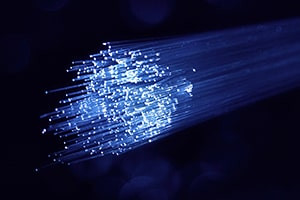Fiber optic communication is a method of carrying information from one point to another by emitting pulses of infrared light through an optical fiber. Point-to-point links are the simplest form of fiber-optic communication systems. Their main role is to transport information, in the form of a digital bitstream, from one place to another with high accuracy. Links can vary in length from less than a kilometer to thousands of kilometers, depending on the application that is required. In this course, the essential components in a data communication system will be discussed, and you will see how each component communicates with the other to facilitate the physical transfer of data. You will also learn how communication has evolved over the years from early humans who could express thoughts and feelings using speech or by signs or gestures, until today. The ancient techniques of communication had two constraints and these were limited to the time in which communication could take place. Recently, landlines have replaced the telegraph, and cell phones have displaced landlines. The arrival of the Internet opened new opportunities for personal communication. The email replaced postal services and social media took over text messaging.
You will learn how fiber optics reformed communications technology. Fiber optics were originally primarily trunk cable lines designed to carry signals to larger populated areas. Over time, these cables extended their reach to homes and buildings and are the backbone for MANs (metropolitan area network), WANs (wide area network) and LANs (local area network). Almost every modern-day device that requires the transmission of data is powered by optical communication. This course will enlighten you on how this process takes place. The optical transmitters that are commonly used are semiconductor devices such as light-emitting diodes (LEDs) and laser diodes. The main difference between LEDs and laser diodes is that LEDs provide incoherent light, while laser diodes produce coherent light. A photodetector, which is the main component of an optical receiver, and converts light into electricity using the photoelectric effect, is explained. Today, LEDs have been largely superseded by VCSEL (vertical cavity surface emitting laser) devices, which offer improved speed, power and spectral properties, at a similar cost. VCSEL devices couple well to multimode fiber. Fiber optic communication technology allows for improved communication as it enables more users at a time on servers as well as faster speeds.
Fiber optics is continuously replacing other technologies and is one of the main technologies enabling the global growth of digital communication. Optical fiber is used by telecommunications companies to transmit telephone signals, Internet communication and cable television signals. Today, many companies and private individuals use fiber optic communication technology. Aircraft pilots often use visual approach slope indicator projected light systems to land safely, especially at night. Military aircraft approaching an aircraft carrier use a similar system to land correctly. Optical communication is used in many industries. If you are considering a career in medicine, defense, networking, broadcasting or if you are tech-savvy and would like to know how your communication devices operate and the work that goes into them performing well, then this course is for you. Why wait? Start this course today and join the industry that is changing how we work!
What You Will Learn In This Free Course
View All Learning Outcomes View Less All Alison courses are free to enrol, study, and complete. To successfully complete this Certificate course and become an Alison Graduate, you need to achieve 80% or higher in each course assessment.
Once you have completed this Certificate course, you have the option to acquire an official Certificate, which is a great way to share your achievement with the world.
Your Alison certificate is:
- Ideal for sharing with potential employers.
- Great for your CV, professional social media profiles, and job applications.
- An indication of your commitment to continuously learn, upskill, and achieve high results.
- An incentive for you to continue empowering yourself through lifelong learning.
Alison offers 2 types of Certificate for completed Certificate courses:
- Digital Certificate: a downloadable Certificate in PDF format immediately available to you when you complete your purchase.
- Physical Certificate: a physical version of your officially branded and security-marked Certificate
All Certificate are available to purchase through the Alison Shop. For more information on purchasing Alison Certificate, please visit our FAQs. If you decide not to purchase your Alison Certificate, you can still demonstrate your achievement by sharing your Learner Record or Learner Achievement Verification, both of which are accessible from your Account Settings.











 Avg. Hours
Avg. Hours  Contains Video
Contains Video  CPD Accredited
CPD Accredited 
 Total XP:
Total XP: 
 Knowledge & Skills You Will Learn
Knowledge & Skills You Will Learn 







